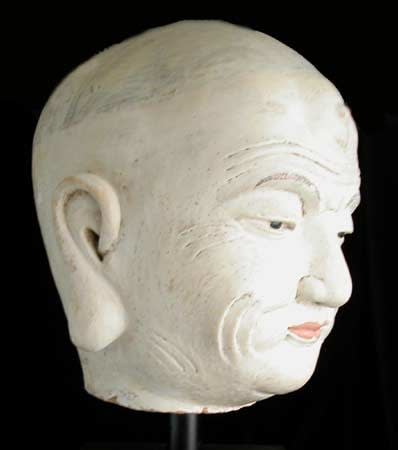Yuan Painted Terracotta Head of a Lohan, 1264 CE - 1368 CE
Painted Terracotta
10.5
H.832
Further images
The Yuan Dynasty was established by Kublai Khan, the grandson of Genghis Khan, upon relocating the capital of his empire from Mongolia to Beijing. The Forbidden City was constructed, a...
The Yuan Dynasty was established by Kublai Khan, the grandson of Genghis Khan, upon relocating the capital of his empire from Mongolia to Beijing. The Forbidden City was constructed, a relative oasis of Mongolian culture in the heart of China. While the Mongol elite retained their native language and customs, they did adapt the Chinese system of bureaucratic government and cemented the authoritarian rule of the emperor. Although they were unaffected by Chinese culture, the Yuan did little to stifle the native traditions and beliefs of their subjects. Buddhism continued to flourish, although the monasteries received little funding from the state. In fact, during the Yuan Dynasty, China first began to open up to foreigners. Christian and Hindu missionaries were established in Beijing and Marco Polo made his famous journey during the Yuan era. While the Chinese never accepted the Yuan as a legitimate dynasty, instead viewing them as foreign bandits, the Mongolians rebelled against the Beijing Khans for becoming, “too Chinese.” In the end, the Yuan Dynasty had the shortest duration of the major Chinese Dynasties, lasting little more than a hundred years.
Even today, when entering the main hall of a Buddhist temple in China, one will discover two rows of sculpted figures, traditionally numbering eighteen in total. These figures are known as the Eighteen Lohan. Lohan is the Chinese term, derived from the Sanskrit word , for a disciple or follower of Buddha who has reached a state of enlightenment. The Lohan had been a popular subject in Chinese art at least since the cultural flourishing of the T’ang Dynasty. Traditionally, they are always produced in sets of sixteen or eighteen. The numerical difference is a result of discrepancies in Buddhist texts. By the Song Dynasty, artists began to depict each Lohan with individualized facial features. The creases of this Lohan’s face are clearly defined, revealing the years of his long life. A small mound rises from his wrinkled forehead, called an ushnisa, which is a symbol of his universal wisdom. His head is painted white, highlighted with pink for his lips and black for his pupils and eyebrows.
Even today, when entering the main hall of a Buddhist temple in China, one will discover two rows of sculpted figures, traditionally numbering eighteen in total. These figures are known as the Eighteen Lohan. Lohan is the Chinese term, derived from the Sanskrit word , for a disciple or follower of Buddha who has reached a state of enlightenment. The Lohan had been a popular subject in Chinese art at least since the cultural flourishing of the T’ang Dynasty. Traditionally, they are always produced in sets of sixteen or eighteen. The numerical difference is a result of discrepancies in Buddhist texts. By the Song Dynasty, artists began to depict each Lohan with individualized facial features. The creases of this Lohan’s face are clearly defined, revealing the years of his long life. A small mound rises from his wrinkled forehead, called an ushnisa, which is a symbol of his universal wisdom. His head is painted white, highlighted with pink for his lips and black for his pupils and eyebrows.









